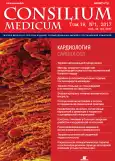Rational antiarrhythmic therapy in postoperative period of pulmonary vein ostia catheter isolation according to the efficacy and safety, for prevention of early recurrences of atrial tachyarrhythmias
- Authors: Tarasov A.V1, Davtyan K.V1, Miller O.N2
-
Affiliations:
- State Research Center for Preventive Medicine of the Ministry of Health of the Russian Federation
- Novosibirsk State Medical University
- Issue: Vol 19, No 1 (2017)
- Pages: 81-87
- Section: Articles
- URL: https://journals.rcsi.science/2075-1753/article/view/94693
- ID: 94693
Cite item
Full Text
Abstract
Full Text
##article.viewOnOriginalSite##About the authors
A. V Tarasov
State Research Center for Preventive Medicine of the Ministry of Health of the Russian Federation
Email: a730tv@yandex.ru
канд. мед. наук, ст. науч. сотр. лаб. рентгенохирургических методов лечения аритмий сердца ФГБУ ГНИЦ ПМ 101990, Russian Federation, Moscow, Petroverigskii per., d. 10, str. 3
K. V Davtyan
State Research Center for Preventive Medicine of the Ministry of Health of the Russian Federationд-р мед. наук, зав. лаб. рентгенохирургических методов лечения аритмий сердца ФГБУ ГНИЦ ПМ 101990, Russian Federation, Moscow, Petroverigskii per., d. 10, str. 3
O. N Miller
Novosibirsk State Medical Universityд-р мед. наук, проф. каф. неотложной терапии с эндокринологией и профпатологией фак-та повышения квалификации и профессиональной переподготовки врачей ФГБОУ ВО НГМУ 630091, Russian Federation, Novosibirsk, Krasnyi pr-t, d. 52
References
- Kirchhof P, Benussi S, Kotecha D et al. 2016 ESC Guidelines for the management of atrial fibrillation developed in collaboration with EACTS. The Task Force for the management of atrial fibrillation of the ESC. Developed with the special contribution of the EHRA of the ESC. Endorsed by the ESO. Eur Heart J doi: 10.1093/eurheartj/ehw210
- Диагностика и лечение фибрилляции предсердий. Рекомендации РКО и ВНОА, 2012. Рос. кардиол. журн. 2013; 4 (102), прил. 3: 6-7, 61-76.
- Schotten U, Verheule S, Kirchhof P, Goette A. Pathophysiological mechanisms of atrial fibrillation - a translational appraisal. Physiol Rev 2010.
- Pappone E, Rosanio S, Oreto G et al. Circumferential Radiofrequency Ablation of Pulmonary Vein Ostia A New Anatomic Approach for Curing Atrial Fibrillation Carlo. Circulation 2000; 102: 2619-28.
- Calkins H, Kuck K.H, Cappato R et al. 2012 HRS/EHRA/ECAS Expert Consensus statement on catheter and surgical ablation of atrial fibrillation: recommendations for patient selection, procedural techniques, patient management and follow - up, definitions, endpoints, and research trial design. Europace 2012; 14 (4): 528-606.
- Wilber D.J, Pappone C, Neuzil P et al. Comparison of antiarrhythmic drug therapy and radiofrequency catheter ablation in patients with paroxysmal atrial fibrillation: a randomized controlled trial. JAMA 2010; 303 (4): 333-40.
- Bonanno C, Paccanaro M, La Vecchia L et al. Efficacy and safety of catheter ablation versus antiarrhythmic drugs for atrial fibrillation: a meta - analysis of randomized trials. J Cardiovasc Med (Hagerstown) 2010; 11 (6): 408-18.
- Bertaglia E, Stabile G, Senatore G et al. Predictive value of early atrial tachyarrhythmias recurrence after circumferential anatomical pulmonary vein ablation. Pacing Clin Electrophysiol 2005; 28 (5): 366-71.
- Тарасов А.В., Давтян К.В., Марцевич С.Ю., Шатахцян В.С. Профилактика предсердных тахиаритмий в послеоперационном периоде катетерной изоляции устьев легочных вен у пациентов с пароксизмальной формой фибрилляции предсердий. Кардиоваскулярная терапия и профилактика. 2016; 15 (5): 43-9.
- Тарасов А.В., Давтян К.В., Миллер О.Н., Шатахцян В.С. Эффективность антиаритмической терапии в раннем послеоперационном периоде катетерной изоляции устьев легочных для лечения пароксизмальной формы фибрилляции предсердий // Consilium Medicum. 2016; 18 (12): 49-54.
- Тарасов А.В. Вопросы безопасности антиаритмической терапии // Consilium Medicum. 2014; 16 (10): 44-9.
- Goldenberg G.R, Burd D, Lodzinski P et al. Antiarrhythmic therapy as an adjuvant to promote post pulmonary vein isolation success - a meta - analysis. J Interv Card Electrophysiol 2016; 21: 98-109.
- Turco P, De Simone A, La Rocca V et al. Antiarrhythmic drug therapy after radiofrequency catheter ablation in patients with atrial fibrillation. Pacing Clin Electrophysiol 2007; 30: S112-115.
- Gang Wu, Hong Jiang, Cong-xin Huang et al. Effects of early postoperative antiarrhythmic drugs on atrial fibrillation recurrence in the circumferential ablation of pulmonary vein. Chin J Canliol 2008; 36: 7.
- Darcner S, Chen X, Hansen J et al. Recurrence of arrhythmia following short - term oral AMIOdarone after CATheter ablation for atrial fibrillation: a double - blind,radiomized, placebo - controlled study (AMIO-CAT trial). Eur Heart J 2014; 35: 3356-64.
- Hayashi M, Miyauchi Y, Iwasaki Y.K et al. Three - month lower - dose flecainide after catheter ablation of atrial fibrillation. Europace 2014; 16: 1160-7.
- Kaitani K, Inoue K, Kobori A et al. EAST-AF trial investigators. Efficacy of antiarrhythmic drugs short - term use after catheter ablation for atrial fibrillation (EAST-EF) trial. Eur Heart J 2016; 37 (7); 610-8.
Supplementary files






